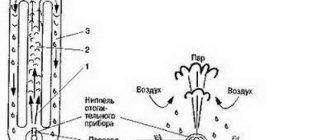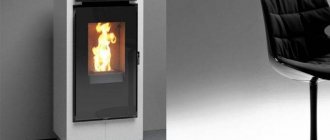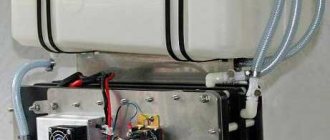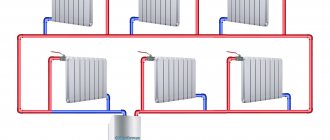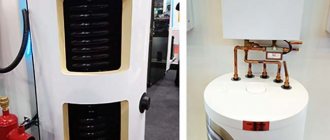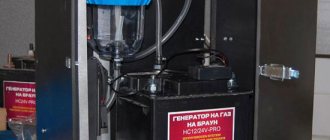Even if we are not talking about a large garage where people work, it should still be warm.
This will extend the life of the car, help you start the car in extreme cold, and keep you warm if you need to repair something.
The decision on how to organize garage heating with your own hands must consist of three conditions: it must be warm, safe and economical. Let's figure out how to make heating in the garage.
Water heating
Water heating is most often used in garages attached to a private house, from which a branch can be installed and heated with one boiler. In cooperatives, a centralized heating scheme is being developed for several garages.
If we are talking about a private garage, where the owner does not visit every day, do-it-yourself water heating, especially in combination with an electric boiler, is not the most suitable option, because a person cannot monitor the condition of the pipes in the event of a power outage.
Garage water heating scheme
Defrosting can happen at any time. Antifreeze instead of water can save the situation, but it has low heat transfer, and this heating method cannot be called economical.
For water heating with natural air circulation, an expansion tank must be installed at the highest point. Usually it is hidden in the attic, but in the garage you will need to install it under the ceiling.
Installation of a water heating system
How to make water heating - this question must be planned to the smallest detail, in the literal sense of the word. Planning should be done by professionals. Usually the planning process begins precisely from the place where the boiler will be placed; it is installed even before planning the pipe layout. Of course, professionals know how to do hydronic heating correctly, so it would be best to invite one of them, especially during the planning stage.
Professional drawing of a heating system
When you have decided where the boiler will be, a concrete pedestal is made specifically for it, the height is 40-50 mm. After installing the boiler on the pedestal, you need to connect it to the chimney and cover all the cracks at the joints with clay.
When you have installed the boiler, do-it-yourself water heating installation continues with the step of drawing the pipe layout diagram
Here it is necessary to carefully and carefully consider the placement of risers, pipes and radiators, so it would be advisable to invite a specialist for this. Radiators are best placed under windows so that the warm air from them heats the surface of the inner glass and frame
Installation of heating radiators
The cross-section of the pipes and the material for their manufacture should be selected based on your own financial capabilities and the overall length of the heating circuit: the larger the cross-section of the main pipes, the easier it will be for water to flow through them.
The next stage of work on arranging a water heating system for a dacha with your own hands is the installation of a pipeline and installation of radiators. Everything here is quite simple: the pipe is brought out to the position of the radiator, then it is placed, all the inputs and outputs are connected, after which the pipe is led to another radiator, and so on. It will be very convenient if you put a tap on each radiator; this will allow you to remove air pockets.
Next, the heating circuit must be closed in the same place where it began - in the boiler. A filter is installed at the inlet to the boiler, and also, if necessary, a forced circulation pump. At the lowest point of the system, a water drain-fill unit should be installed so that during repairs or liquidation of heating, all the water can be drained.
The first test of the heating boiler must be carried out only together with a specialist.
Heat guns
The advantage of such a unit is its simplicity of design and maintenance (you can make it yourself).
The room warms up quickly.
DIY heat gun
The bad thing is that, along with the air, the gun drives garage dust around the confined space. Breathing this air is not very useful for the owner, because it may contain toxic substances. In addition, if you wash your car, particles of dust, sand, etc. will stick to it.
The main problem with do-it-yourself air heating of a garage: the heated air instantly evaporates as soon as the garage door is opened.
What you will need during installation
The best place to start is by choosing the appropriate boiler model. It must be designed for a water circuit, and also be powerful enough to heat the entire room. There are many existing models, so be sure to consult the seller before purchasing. To create an effective and safe garage water heating system, you need to purchase an expansion tank complete with the boiler, which will contain water. If it is necessary to add water to the system, an expansion tank will make it possible to quickly solve this problem.
Required tools and materials:
- Metal radiators. The quantity also needs to be agreed upon depending on the size of the room, the chosen model and material. You can consider the option of making such products yourself. For this purpose, metal pipes of sufficiently large diameter are used, fastened together. Hot water passing through such a “labyrinth” heats the metal surface. The effect is exactly the same, and the costs are significantly lower.
- Connecting pipes. Metal pipes must be fastened using a welding machine, so for water heating of a garage it is better to use metal-plastic ones. The required diameter is determined by the size of the room.
- To comfortably fasten the pipeline into one piece, you need a special apparatus for cutting and soldering pipes, as well as connecting fittings and plugs of the specified parameters.
- Sealant must be used to connect parts of the system. Traditional tow will be ineffective if antifreeze circulates in the system, so it is worth paying attention to its modern analogues.
- Bench wrenches of the required diameter for fastening joints.
The easiest way is to first draw up a plan for a water heating system on paper. This is done taking into account the actual size of the room, its volume and preferred temperature conditions. A garage, by definition, does not belong to residential buildings, so heating it to the maximum is impractical.
Gas
There are two options here:
1. Main gas.
2. Gas from cylinders.
You can install a stove or heater that runs on gas yourself, but only specialists can install the main line. Gasification of an object is troublesome - you need to draw up the necessary documents. In addition, most garages are not spacious enough to be heated with gas according to regulations.
Gas heating of a garage using a cylinder
If the highway is nearby and you solve all the problems with documentation, this fuel can become one of the most economical options for you.
The feasibility of heating with cylinders will depend on what kind of heater will be used and how effective it is. You can change the cylinders every 3-6 days, or maybe it will last for a month (as, for example, when using a gas boiler).
In severe frosts, places where gas cylinders are stored must be specially insulated.
A gas boiler:
- Has a security system that will turn off the gas in a critical situation;
- They can be very compact and hang on the wall;
- Will last from 10 years or more;
- When connected to a thermostat, they can maintain a minimum t.
Mobile heat sources
These include various electric heaters and heat guns. They are compact, do not take up much space and can be hung on the wall or installed on the floor. Be aware of high power consumption. Therefore, when using them, you should take into account the loads that the network will withstand. A heat gun will require a three-phase network or a wire with a large cross-section. The heater can also operate on gas, but using cylinders in a small garage is unsafe.
Infrared devices for heating a garage with electricity transfer heat to all surfaces of the room. Heated objects will also radiate heat. This is safe for humans, but can negatively affect the car's paint. Therefore, it is better to direct this flow to the garage door. You can do this method of economical garage heating with your own hands by studying the step-by-step instructions.
Convectors heat up themselves and give off heat easily. When turned off, they do not cool down for a long time.
If your budget allows, buy an inverter split system to heat your garage. The air conditioner can operate at temperatures down to -20 degrees. This type of garage heating will save energy and maintain a constant temperature.
Electrical
If your garage is well-wired, DIY electric garage heating may be the simplest option. You just need to install a simple home heater.
Electric heating using an electric boiler is an economical method of organizing heating
You can supplement this system with a fan, thanks to which the air will be mixed faster. This system is suitable if you plan to stay in the garage infrequently and for a short time.
An infrared heater can be a type of electric heating. It is installed above the door in the garage, thereby creating a thermal curtain. It is recommended to use it with high ceilings - from 2.5 m.
Heat distribution diagram when using an infrared heater in a garage
Another option is an electric boiler. If the garage is well insulated, heating it with electricity can be economically feasible.
Electric boiler:
- It will turn off itself in case of overheating;
- It will turn on itself after a short power outage;
- Does not require constant control of the owner;
- It can be equipped with a module that allows you to control the system via a mobile phone.
If you are a lover of hunting and fishing, then you probably need a portable heater. Do-it-yourself infrared heater - features and principle of operation, as well as different types of IR systems with step-by-step manufacturing instructions. Read about how to choose a circulation pump for heating here.
And here https://aquacomm.ru/vodosnabzenie/zagorodnyie-doma-v/dvuhkonturnyie-kotlyi-otopleniya-kak-vyibrat.html details on how to choose a heating steam boiler. Single-circuit and double-circuit systems.
Electric heating
The simplest and relatively affordable method is electric heating, for the arrangement of which it is enough to purchase the appropriate equipment. A wide variety of options, mobility and compactness are the main advantages. However, costs will directly depend on the established electricity tariffs.
Before installing electric heating, you need to choose the most suitable device:
- Electric inverter
- Infrared heater
- Heat gun
Among the types of electric heating, the most effective is the inverter or “heater”. There are a huge number of models on the market that are installed on the floor or hung on the wall. They are quite compact, but at the same time very productive.
The approximate cost of an electric inverter is from 10 thousand rubles.
A compact and effective solution is the installation of IR heaters - a fairly powerful and productive device
However, paying attention to the rapid heating of the room, they are not able to cope with large areas. Negative aspects are also high energy consumption and prices for corresponding installations
Find out more about infrared heating
The average cost of an infrared heater is from 4 thousand rubles.
Heat guns are considered compact, efficient and convenient, capable of heating a garage space in the shortest possible time. They consist of a heater and a fan that dissipates heat into the environment. However, to connect such equipment, it is necessary to have a single-phase network with a large cross-section of the wire being laid or a 3-phase network (the latter is preferable).
The cost of heat guns is from 5 thousand rubles.
Potbelly stove
It is a “classic” when arranging garage heating with your own hands:
- Easily made independently, for example, from a barrel or a piece of pipe;
- Does not require a full chimney or installation on a foundation;
- It is heated with simple and reliable fuel - wood or coal. The owner of a garage with a potbelly stove does not depend on the supply of energy from outside;
- Compact;
- Heats up quickly.
Do-it-yourself potbelly stove diagram for a garage
The thickness of the metal used for the potbelly stove must be 5 mm or more!
But there are also significant disadvantages. A potbelly stove has a low heat capacity (it’s hot near the stove, but cold a little further away; it heats up quickly, but also cools down quickly). If the garage is large, heating it will be difficult.
Firewood needs to be thrown in quite often. The efficiency of a potbelly stove is only about 10-15%
How to choose the type of garage heating?
Garage heating must correspond to the specifics of the room and be:
- Safe. Where there is a car, there are a lot of flammable substances, so it is necessary to minimize the possibility of their contact with an open flame. It is not advisable to install homemade stoves and burners using liquid fuel in the garage (of course, not all of them, but many are made in such a way that when boiling, the burning oil can splash out).
- Adapted to temperature changes. The garage has a large door and when it is opened once, most of the heated air escapes to the street.
- Autonomous. If the garage is located away from the house, heating should not depend on external conditions and resources.
- On available fuel. It is this condition that is relied upon when choosing a heater.
- Inexpensive. Since few people try to invest huge amounts of money in the garage, they prefer an economy class stove or heater.
- Easy to maintain. Most likely, the owner does not need unnecessary worries with regular cleaning of carbon deposits. The heat source should require minimal attention.
- Compact. The heater must be located at a certain distance from the car, not interfere with the movement of a person and not steal space for yourself or a supply of fuel.
In addition, the heater must be selected according to the size of the room, the presence or absence of an inspection hole and the time that the owner plans to spend here.
Buleryan
This is a more advanced stove and an excellent alternative to a potbelly stove.
Buleryan's efficiency is about 80%. Firewood needs to be added only once every 6-12 hours.
The only disadvantages include the high cost of the unit itself.
However, Buleryan can be made independently, which will significantly reduce costs.
Do not use flammable liquids to ignite Buleryan.
You also need to pay close attention to the insulation of the chimney. If there are errors in installation and insulation, the pipes will begin to constantly become clogged.
Pros and cons of a heated garage
Heating in a metal garage during the cold season creates comfortable conditions for car repairs.
The advantages of a heated room include the following factors:
Properly executed heating of a metal garage allows you to create comfortable conditions for repairs, which is important when the premises are used frequently. It is easier to start a car engine in a warm environment because the engine oil will not become thicker. Due to the easier starting of the engine, its parts are subject to reduced wear. Heating the garage in winter allows you to wash your car without fear of the locks freezing.
Heating installations have several disadvantages. These include a number of points:
- Obligatory costs for electricity or other types of fuel.
- Some types of systems are quite expensive to install and maintain; they pay for themselves only after 4-6 years from the date of purchase.
- Increased fire danger, the need to comply with a number of rules during installation.
Solid fuel boiler
Modern long-burning boilers can greatly improve heating efficiency.
If you put firewood in such a boiler, it will work from 4 to 10 days. On coal, the terms increase to 14 days! The owner can only decide whether he can periodically control the combustion process.
Pellets are a type of fuel that can be loaded into the boiler once a month. Recycled wood pellets have high heat transfer properties due to their high density.
You can make a long-burning wood stove yourself from an ordinary metal barrel with a volume of about 200 liters.
To install it you will need a chimney and a solid foundation.
Cable floor installation
As mentioned above, cable floors run on electricity, and since the tariffs are quite high, the costs are significant.
Therefore, it is necessary to think through all the ways to save it: the heat capacity of walls and ceilings, the quality of thermal insulation, which we will discuss in detail in this article.
Installation of electric heated floors in a garage
Calculation
The installation of cable electric heating, as well as the installation of an infrared system, should begin with calculating the power; there is a single formula for this.
You can familiarize yourself with the rules for calculating power in the section “Installation of infrared flooring”.
Drawing up a diagram
Before installing any heated floor, it is necessary to prepare a diagram showing the cable laying areas and the location of the regulator.
According to SNiP, if the area of the heating elements exceeds 40 m2, then damper gaps must be made. The rules for placing the mat are similar to laying the film.
Required tools and materials
Before proceeding directly to installing the heating system, you need to purchase the material and prepare the tools that you will need if you are going to do the installation yourself.
First you need to choose the type of heating:
- Resistive cable - there is one or two wires. It produces heat energy, its volume depends on the cross-section of the wire.
- The heating mat is a flexible sheet with a resistive wire already fixed on it. It is comfortable and easy to install.
Any model is suitable for installation in a garage.
The remaining materials and tools for constructing cable heating are the same as for installing an infrared system.
Preparing the base
Preparing a rough base in the garage for laying cables is no different from these works; when installing any heated floor - leveling and cleaning the surface.
Thermal insulation
The detailed process of hydro and thermal insulation is described in the section on infrared floors; it is the same for all electrical systems. That is, polyethylene is laid, damper tape is installed, insulation and fittings are installed.
Laying heating elements
Installation of the heating cable is carried out according to the developed scheme (“snake” or “snail”), for this purpose markings are applied to the insulation. According to these marks, the wire is laid in turns, the standard distance between which is 0.3 meters .
The circuits should be placed parallel, the cable should be bent at an angle of less than 90 degrees or it should be excessively stretched. The wire must be solid, without twisting, as this will affect the quality of work and service life. The cable is fixed to the mesh with clips or antennae on the mounting tape, which is attached to the insulation.
When laying heating mats, the work of installing a warm electric floor in the garage is greatly simplified, because the wire is already fixed to a special mesh. You just need to roll out the mats on the surface and fix them.
INSTALLATION OF ELECTRIC WARM FLOOR IN GROOTS
Connection
A mounting box is attached to the planned location, into which the thermostat is installed. A power and grounding cable is supplied to it.
To install a temperature sensor in the insulation at a distance of 0.5 meters from the wall, it is necessary to make a recess. A corrugated pipe with a sensor placed inside is placed in it. The wire from the sensor is also connected to the regulator.
After connecting, the device must be checked for functionality. The heated floor must be plugged into a separate outlet.
Filling the screed
The solution for pouring the cable floor and the process itself is similar to concreting an infrared system. A concrete screed can be used as a finishing surface in a garage, but it is permissible to lay tiles on top if desired.
Waste oil heating system
It is clear that buying oil specifically and spending it on heating the garage is very expensive. It only makes sense to build a furnace for exhaustion if you have a free source of this fuel at your disposal.
Making such a stove yourself is a little more difficult than a potbelly stove, but it is possible.
Diagram of a homemade waste oil boiler
Such a furnace consists of two sections: in the first, waste is burned, in the second, the resulting gases are burned.
Steel sometimes becomes white-hot, so safety is of great importance when working with it.
Cautions:
- Due to fuel instability, equipment may fail;
- Acetone and gasoline can only be used for ignition!
- An exhaust burner is often made from old gas cylinders. To avoid an explosion, before starting work, you need to twist the valve and thoroughly rinse the cylinder with water.
Heating a garage with electricity is the most economical way
Fan heater
Why the fan heater become so popular among garage owners? There are several advantages of this device:
- The device takes up little space . It is easy to move and install in the place desired by the owner.
- The room heats up very quickly .
- The device is easy to use. intensity at any time . There is a speed switch for this.
- Low cost is another advantage of this heating method.
- When the set heating temperature is reached, the fan heater turns off automatically.
elements act as a heat exchanger in this device . During operation, the fan drives air through heated heating elements.
The disadvantages of this heating method include the following features:
- The device dries the air . Because of this, it cannot be used for a long time.
- Dust particles periodically enter the heating elements of the fan heater During the heating process they burn. As a result, an unpleasant odor is formed.
- Increased noise .
Convector
From the point of view of uniform heating, convector is more efficient. However, heating with a convector is more expensive . The design of the device consists of a protected housing. This allows it to be used in rooms with high humidity.
Manufacturers produce convectors in 2 versions:
- for mounting directly on the wall;
- for installation on the floor.
When purchasing, be sure to consider the power level of the device.
Advantages of the convector:
- Works in automatic mode. There are 5 room heating modes. Having reached the specified temperature, heating stops.
- Ease of installation and operation.
- The device is reliable and durable.
- Safety.
Disadvantages of the convector:
- costs more than other types of heaters;
- consumes quite a lot of electricity;
- The process of heating the room takes longer than when using fan heaters. To reach the optimal temperature you will have to wait about 30 minutes.
Infrared heater
Economical heating of a garage with electricity can be done using an infrared heater . Heating of the surfaces of objects occurs due to the rays emitted by the device. However, this method does not ensure uniform heating of the garage.
Part of the room will remain cold . It will only be comfortable where the heater is installed. Although most car enthusiasts do not see the point in heating the entire room. It is enough for them to heat the place in which they work.
The number of modifications of infrared heaters produced by manufacturers is simply enormous. There are devices that can be mounted on the ceiling or wall.
When purchasing a device, pay attention to the ceiling version . During the same time, it is able to heat a larger number of items in the garage. If desired, this heater model can be used outdoors. To do this, you just need to send it to the repair site. Infrared rays do not pose any danger.
Owners of infrared heaters note that the device:
- Saves energy.
- Heats a garage of any size. Moreover, it can be used both indoors and outdoors.
- The device does not require much time to master.
- The device is not only reliable, but also safe.
Disadvantages of an infrared heater:
- This type of heating does not pose any danger to humans. But the same cannot be said about the car. The action of this device damages the paintwork . Therefore, you should not install it above the car.
- During operation, the housing becomes very hot. This heater should not be left unattended.
Warm floor system
“warm floor” system is that the garage is evenly heated over the entire area. Moreover, a comfortable temperature can be achieved in a short time. This allows the garage owner to save energy.
Before installing the system, there are several points to consider:
- think over the cable layout;
- the place where the heated floor is connected to the electrical network;
- location of the sensor and thermostat.
First, we prepare the floor for laying the cable. We level the floor surface and cover it with a heat insulator. After this, we form a layer of cement screed. Its thickness should be at least 1 cm.
Then we proceed to laying out the electrical cable. To secure it to the prepared coating, we will use a special mesh or mounting tape. Please note that the thermal insulation layer does not have high strength. There is a possibility of the cable being pressed into the coating. This may cause the system to overheat. It is better to use wire mesh rather than mounting tape.
It is important to maintain a spacing when laying the mesh to avoid overlap. When installing a heated floor in a garage, it is best to use a two-core cable. It has a lower level of electromagnetic background. In addition, it is more convenient to use.
To check the serviceability of the heating element, you need to measure its insulation .
Installing a thermostat will allow you to save on heating your garage. You can see 2 types of these devices on sale:
- With air sensor mounted above the floor. Moreover, it must be at a height of at least 160 cm from the floor level.
- With a sensor that is mounted directly in the floor. To protect the device from mechanical damage, a corrugated pipe with a plug is used.
At the last stage of work, we bring out the ends of the cable to the thermostat. After this, fill the system with solution .
There is another type of heated floor - water . Read more about it in the article.
Fire safety of homemade heating systems
A very important requirement for garage stoves is that they should not emit combustion products.
In a small space, a person can quickly “inhale” harmful substances.
In addition to the usual potential dangers, the garage adds another one - unsuccessful entry of a car, which can damage heating appliances and furnaces.
Their location should be thought out with this in mind. The ideal option is to install the heater in a special niche covered with a protective screen.
According to fire safety regulations, it is prohibited to store lubricants and fuel in garages. For most people, the question arises: “Where else should I store this if not in the garage?” If you are forced to break this safety rule, then you need to at least make sure that flammable substances are as far away from heating appliances as possible.
Electric heaters can only be used when the owner is in the garage - they cannot be turned on at night.
It is necessary to ensure that the thermal effect does not directly affect the paint of the car.
So, choosing a DIY garage heating system is largely individual. Is the garage freestanding, part of a co-op, or attached to the house? What are the dimensions of the room, how often will the owner visit it, and what energy resources are available to him. All this needs to be taken into account when deciding on a method for heating the garage with your own hands.
And when the choice is made, you can make a lot yourself.
When building a private house, you need to decide on the heating system. Do-it-yourself air heating of a private house - an outdated or modern way of heating a room? Pros and cons of the system. Read about whether it is economical to install heated floors in your home in this topic.
Autonomous or combined with the house water heating?
To heat the garage, you can use an existing central heating line or install a new, autonomous one. The first option is suitable for technical premises that are an extension to a residential building or located in close proximity to it (maximum 40 meters). The construction of an autonomous boiler room will be economically justified if the garage is a separate building. Autonomous heating will be even more beneficial for garage owners if they equip complex heating for several rooms, for example, within the framework of a garage cooperative.

